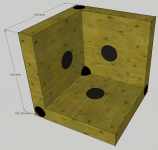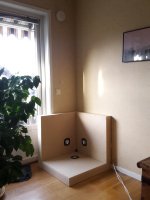Next after having a loudspeaker actually capable of reproducing high spl, very high definition, clean transients with small conemovement and low intermodulation is the actual room acoustics.
Carlsson Ortho-Acoustic Loudspeakers: Design and Performance Principles (English):
Carlsson Ortho-Acoustic Loudspeakers: Design and Performance Principles (English) - CarlssonPlanet
A great PDF.
Early reflections will downgrade the transient response and the subjective experience of punch and sharp detailed reproduction of percussion. I built a pair of Ortoacoustic Unity corners some while ago, and the most striking property was the transients and the definition, especially in the midbass (the main problem area of early reflections combfiltereffects etc in normal loudspeaker/room setups).

There is a Faital Pro 3FE22 in the corner apex and three SB Acoustics 4 inch alu cone bass/midrange drivers per loudspeker. They are activly crossed over at 250 Hz with a MINIDSP.
Carlsson Ortho-Acoustic Loudspeakers: Design and Performance Principles (English):
Carlsson Ortho-Acoustic Loudspeakers: Design and Performance Principles (English) - CarlssonPlanet
A great PDF.
Early reflections will downgrade the transient response and the subjective experience of punch and sharp detailed reproduction of percussion. I built a pair of Ortoacoustic Unity corners some while ago, and the most striking property was the transients and the definition, especially in the midbass (the main problem area of early reflections combfiltereffects etc in normal loudspeaker/room setups).

There is a Faital Pro 3FE22 in the corner apex and three SB Acoustics 4 inch alu cone bass/midrange drivers per loudspeker. They are activly crossed over at 250 Hz with a MINIDSP.
my wife would have put the plant right on the cabinet to "hide the speakers" and the top edge would accumulate nic nacs...
would changing the square corners to something rounded or even diagonals affect the performance?
could this be inverted and used in the "top" corner of a room?
would changing the square corners to something rounded or even diagonals affect the performance?
could this be inverted and used in the "top" corner of a room?
would changing the square corners to something rounded or even diagonals affect the performance?
could this be inverted and used in the "top" corner of a room?
Probably yes and yes. This was my first foray into this strange hybrid between Unity horns and Stig Karlsson OA-speakers. It was a shock to me, and I am in the middle of a total reevaluation of electroacoustic soundreproduction. I have not had the time, energy or the economy to further the development of these speakers. There are many variations I would like to try, and rounded or diagonal outer surfaces are among those.
It has been a very profound and transformational experience to test this idea, and they are certainly not for everyone. They are absolutly ruthless to recordings and peripherals (amp, CD, soundcard etc).
I only wanted to mention them as an example of ways to avoid lots of room acoustics related problems in high fidelity reproduction of percussive instruments. Early reflections really mess up transients, dynamics and the resolution of much of the fundamentals in many instruments (midbass and lower midrange).
Using a pointsource with a very precise radiating pattern to avoid early relections and to keep the tonal balance, phase and general character between direct and reflected sound is very important to the quality of reproduction of percussive instruments in a listening room.
Are you getting enough late reflections?
They have a 90 x 90 degree radiation angle so I would guess it more depends on the room acoustics and the placing of the loudspeakers.
I started reading the pdf and when I got to the part with weird conspiracy theories about recording engineers trying to fool all of us (except the inventor, of course)..... Classic hokum write-up, even if there is some merit to the product, albeit unlikely.Probably yes and yes....
B.
Last edited:
Good take on it:
Musical Instrument Frequency Range Analysis in Audio Mixing Tutorial
I do like reading of the various opinions and theory no matter how wacky. There's a fine line between genius and insanity.
Acoustics no doubt a player. Always funny to see $10k esoteric systems and not a single form of treatment.
Musical Instrument Frequency Range Analysis in Audio Mixing Tutorial
I do like reading of the various opinions and theory no matter how wacky. There's a fine line between genius and insanity.
Acoustics no doubt a player. Always funny to see $10k esoteric systems and not a single form of treatment.
re: kickdrum, the old Karlson box properly braced (struts to the wings, back braced) does a decent job in its range and keeps cone excursion down. For highhat and other cymbal a K-tube sounds good too. A Karlson setup with K-tube would be excellent for an electronic drum kit. I don't think any of my horns would sound as good and a reflex might have too much excursion and subjective overhang.
Another vote for a Falcon Heavy Launch
YouTube
(This particular track has launch starting at about 9:30 in.)
First time I ever became concerned watching sub drivers' crazy erratic excursion. That combined with the crackling, air ripping-like, sound is WoW
It is not the best idea tu run it on system where there is no overexcursion protection, mechanical or electrical... There is lot of infrasound content. Even not going full volume can be dangerous to unloaded drivers. Bass-reflex is popular example.
This one STS-132 launch is also great sounding and more safe to run loud.
Last edited:
Yep, good advice 🙂
It's high quality PA gear that I use for home listening...HPF is in place on PPSL's (bass reflexes tuned to 31Hz) PL380 amp is pretty well matched to run out of gas before thermal or peak trouble. I've watched my 18n862's bounce around alot (19mm xmax)...but never with such erratic acceleration as with that launch track.
It's high quality PA gear that I use for home listening...HPF is in place on PPSL's (bass reflexes tuned to 31Hz) PL380 amp is pretty well matched to run out of gas before thermal or peak trouble. I've watched my 18n862's bounce around alot (19mm xmax)...but never with such erratic acceleration as with that launch track.
Yes, Karlson does a nice job.re: kickdrum, the old Karlson box properly braced (struts to the wings, back braced) does a decent job in its range and keeps cone excursion down. For highhat and other cymbal a K-tube sounds good too. A Karlson setup with K-tube would be excellent for an electronic drum kit. I don't think any of my horns would sound as good and a reflex might have too much excursion and subjective overhang.
Apropos earlier comments (from me and others), the Karlson (admired by Freddi and me sometimes too) is a fairly open, non-resonant kind of mounting and perhaps more similar to a labyrinth than a BR, IMHO.
B.
Member
Joined 2009
Paid Member
I started reading the pdf and when I got to the part with weird conspiracy theories about recording engineers trying to fool all of us (except the inventor, of course)..... Classic hokum write-up, even if there is some merit to the product, albeit unlikely.
B.
The guy credited with patenting the triode didn’t know what he was talking about either (credit might arguably have been better placed elsewhere) so we can’t always assume there’s no merit in the idea based on a crummy document
Last edited:
Member
Joined 2009
Paid Member
It has been a very profound and transformational experience to test this idea, and they are certainly not for everyone. They are absolutly ruthless to recordings and peripherals (amp, CD, soundcard etc).
Observations like this suggests it’s worthy of exploration
Last edited:
I got to the part with weird conspiracy theories about recording engineers trying to fool all of us
I suggest that you research Stig Carlsson a bit before you dismiss him in this quite uniformed way.
He was a genius and at least 50 years before his time. It is truly remarkable that he accomplished what he did given the poor state of electronics and transducer technology of his time. Like all geniuses that is way ahead of his time, he met a lot of uninformed and dogmatic resistance from people that did not understand his radical approach. He might have a unrelenting a fundamentalist approach to high fidelity reproduction of music, but he was a very scientific engineer and inventor.
I am looking for a set of loudspeaker performance characteristics which define the technical requirements necessary to be achieved for the correct delivery of the timbre, response and dynamics of real percussion instruments.
Greets!
Ideally need to take the room's acoustics into consideration: http://www.akutek.info/Papers/TH_SmallRooms_Timbre_Strength.pdf
GM
Struggling to remain within the bounds of forum and Canadian propriety, I am obliged to limit my reply to: starting to smell worse and worse, eh. But as Bigun says, maybe this persons really is a genius who has been ignored for decades due to the malign influence of the major loudspeaker manufacturers and their hench-persons in the CIA, FBI, and RCMP.I suggest that you research Stig Carlsson a bit before you dismiss him in this quite uniformed way.
He was a genius and at least 50 years before his time. It is truly remarkable that he accomplished what he did given the poor state of electronics and transducer technology of his time. Like all geniuses that is way ahead of his time, he met a lot of uninformed and dogmatic resistance from people that did not understand his radical approach. He might have a unrelenting a fundamentalist approach to high fidelity reproduction of music, but he was a very scientific engineer and inventor.
Perhaps I didn't read the website with enough care, but could Circlomanen please help us locate measurement data or attach his evidence?
B.
- Status
- Not open for further replies.
- Home
- Loudspeakers
- Subwoofers
- Performance characteristics for lifelike reproduction of percussion instruments
